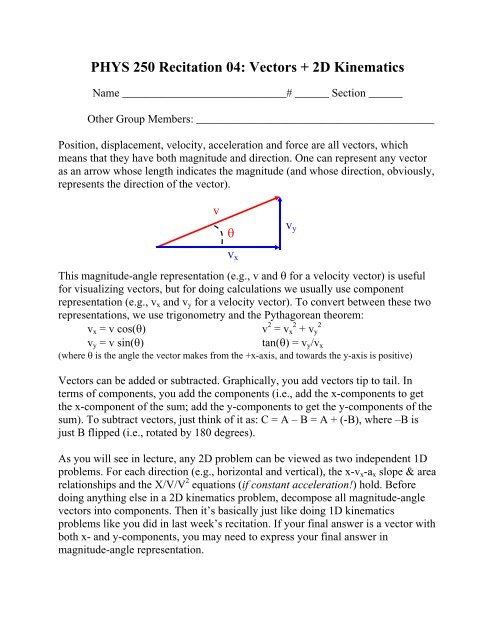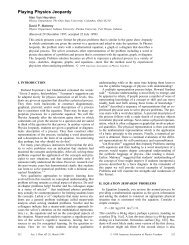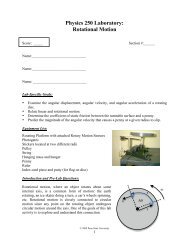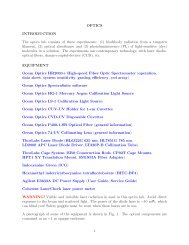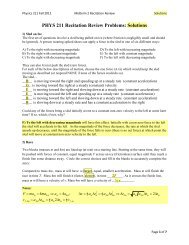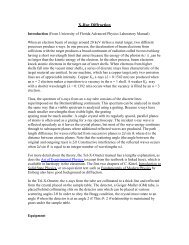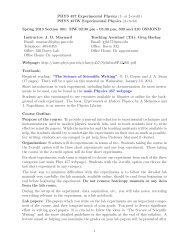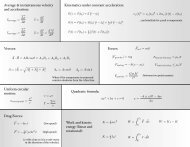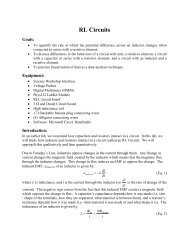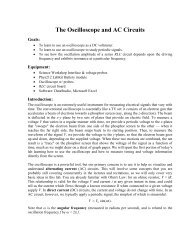Vectors & 2D Kinematics (W & R Recit. only!)
Vectors & 2D Kinematics (W & R Recit. only!)
Vectors & 2D Kinematics (W & R Recit. only!)
You also want an ePaper? Increase the reach of your titles
YUMPU automatically turns print PDFs into web optimized ePapers that Google loves.
PHYS 250 <strong>Recit</strong>ation 04: <strong>Vectors</strong> + <strong>2D</strong> <strong>Kinematics</strong><br />
Name _____________________________# ______ Section ______<br />
Other Group Members: __________________________________________<br />
Position, displacement, velocity, acceleration and force are all vectors, which<br />
means that they have both magnitude and direction. One can represent any vector<br />
as an arrow whose length indicates the magnitude (and whose direction, obviously,<br />
represents the direction of the vector).<br />
v<br />
<br />
v x<br />
v y<br />
This magnitude-angle representation (e.g., v and for a velocity vector) is useful<br />
for visualizing vectors, but for doing calculations we usually use component<br />
representation (e.g., v x and v y for a velocity vector). To convert between these two<br />
representations, we use trigonometry and the Pythagorean theorem:<br />
v x = v cos() v 2 = v 2 2<br />
x + v y<br />
v y = v sin()<br />
tan() = v y /v x<br />
(where is the angle the vector makes from the +x-axis, and towards the y-axis is positive)<br />
<strong>Vectors</strong> can be added or subtracted. Graphically, you add vectors tip to tail. In<br />
terms of components, you add the components (i.e., add the x-components to get<br />
the x-component of the sum; add the y-components to get the y-components of the<br />
sum). To subtract vectors, just think of it as: C = A – B = A + (-B), where –B is<br />
just B flipped (i.e., rotated by 180 degrees).<br />
As you will see in lecture, any <strong>2D</strong> problem can be viewed as two independent 1D<br />
problems. For each direction (e.g., horizontal and vertical), the x-v x -a x slope & area<br />
relationships and the X/V/V 2 equations (if constant acceleration!) hold. Before<br />
doing anything else in a <strong>2D</strong> kinematics problem, decompose all magnitude-angle<br />
vectors into components. Then it’s basically just like doing 1D kinematics<br />
problems like you did in last week’s recitation. If your final answer is a vector with<br />
both x- and y-components, you may need to express your final answer in<br />
magnitude-angle representation.
Problem #1. Manipulate vectors A & B below as arrows to draw the solution to the<br />
following expressions:<br />
A<br />
B<br />
a) 2A + B =<br />
b) A – B =<br />
c) Draw C, where A + B + C = 0
Problem #2. Manipulate vectors A & B below in terms of components to calculate<br />
the following quantities:<br />
A = 20 m/s at a 30 degree angle above the x-axis<br />
B = 10 m/s at a 40 degree angle left of the y-axis<br />
a) What are A and B expressed in terms of x- and y-components?<br />
a) A/2 + B =<br />
b) A – 3B =<br />
c) Find the components of C, where A + B + C = 0<br />
d) What is C in terms of magnitude & angle above the x-axis?
Problem #3: A ball is thrown at 20 m/s at an angle of 30 degrees up above the<br />
horizontal. The <strong>only</strong> thing acting on the ball is gravity, so the ball has an<br />
acceleration of 9.8 m/s 2 in the downwards (-y) direction. What is the velocity of the<br />
ball two seconds later? (Assume that it is still in the air at 2 seconds.)<br />
First identify all relevant horizontal and vertical quantities (given/known/implied<br />
or asked for), and those quantities that need to be decomposed into x- and y-<br />
components.<br />
Next, find the vector components, and finally solve the problem (as two separate<br />
1D problems). You can leave your answer in component form.
Problem #4: A penguin sliding on ice has an initial velocity of 5 m/s due north.<br />
Due to a strong wind, the penguin has an acceleration of 2 m/s 2 30 degrees west of<br />
North. What is the penguin’s displacement (magnitude and direction) after 4<br />
seconds?<br />
First identify all relevant x- (East-West) and y- (North-South) quantities<br />
(given/known/implied or asked for), and those quantities that need to be<br />
decomposed into x- and y-components.<br />
Next, find the vector components, and finally solve the problem (as two separate<br />
1D problems). Solve in component form and then convert your answer to<br />
magnitude-angle.


